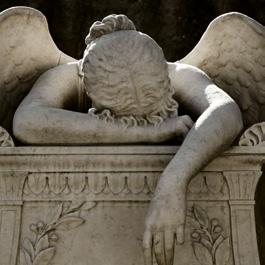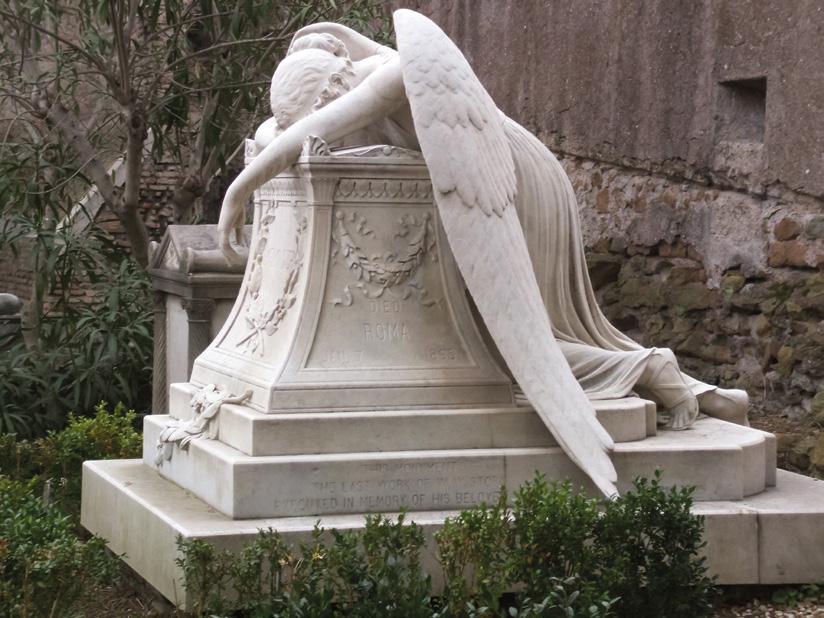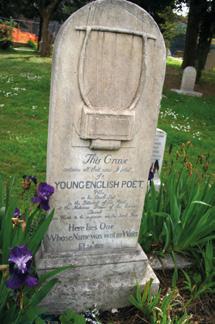
6 minute read
Laid to rest after many a fight


expense) and were also allowed some extra adjoining land. Even so, as late as 1854 the Russian ambassador, when burying his wife, had to hurry away the officiating clergyman in his carriage in order to save him from the wrath of the local citizenry. Two further enlargements, the last in1894, gave the cemetery the dimensions it occupies today.
This tranquil spot on the city’s outskirts is the last resting place for a truly remarkable concentration of artists, writers, musicians and scholars, so many of whom had enriched the cultural life of their nations before they crossed over into their Long Night. Many had come to Rome for their work, others had chosen to live in Italy, and yet others died as a result of illness or accident while visiting the country.
There are many imposing monuments. The one which catches the eye immediately is the magnificent ‘Angel of Grief’, under which lies its creator, the American poet and sculptor W. W. Story who died in Italy in 1881. More numerous than the grand (and grandiose) are the more modest headstones bearing a design and a simple statement of loss, with perhaps some brief details of the life. Of such is the headstone erected to Goethe’s son August, buried here also in 1881. The tomb of the great Italian political theorist Antonio Gramsci (1891-1937) is similarly in keeping with the view that simplicity is always more impressive than magnificence, an aesthetic especially appealing to a modern eye. More modest still are the two graves which are probably of the most interest to English and Irish visitors. This is the cemetery where are laid to rest two of the most illustrious poets in English Literature, the ‘Romantics’ John Keats and Percy Bysshe Shelley.
Keats came to Rome in 1820, riven by the tuberculosis that had previously claimed his mother and his brother Tom and in search of a drier climate that might ease his own suffering. By the following year he had realized that he was nearing his end and asked his friend Joseph Severn to find him a suitable burial place. On hearing of the peaceful atmosphere of the cemetery on Rome’s periphery, he desired to be buried there. Severn fulfilled his friend's wishes in 1821 when death at last claimed the poet at the age of 25. Tragically, Keats’ burial was followed a year later by another of his friends, the poet and political agitator Shelley, who was drowned in a boating accident off the coast of Tuscany at the age of 28.
The simple headstone to Keats stands in the shadow of the pyramid. He had instructed his friend, who had looked after him during his final illness, that he did not want his grave to be marked by any grandiose structures and that his stone should carry, not his name, but only the line ‘here lies one whose name was writ in water’, a version of an old phrase occurring in the writings of the Roman poet Catullus, among others. Clearly the young poet wished to be seen as one of a great tradition of writers, but clearly also his friend Severn had misgivings about this rather bare
Another imposing monument which catches the eye immediately is the magnificent ‘Angel of Grief’, under which lies its creator, the American poet and sculptor W. W. Story who died in Italy in 1881



John Keats and Percy Bysshe Shelley and their graves in the cemetery
inscription and added more information to the stone. Later still, when his own time came in 1879 and he took his place alongside his friend, he included on his own headstone even more details, recording that he had been the ‘devoted friend and death-bed companion of JOHN KEATS whom he lived to see numbered among The Immortal Poets of England’. His decision to ignore Keats’ austere request for a one-line remembrance is a matter of debate to this day. Certainly, if they have met up in an afterlife it would be interesting to hear what Keats had to say on the matter.
A large flat stone, close to the cemetery’s old outer wall commemorates Shelley and bears the inscription (from Shakespeare’s The Tempest):


Nothing of him that doth fade But doth suffer a sea-change Into something rich and strange,
and the Latin phrase ‘Cor Cordium’, (‘heart of hearts’), recalling how in the past the heart was thought to be the origin of all feelings – love, hate, grief, courage – a credo so much a part of the ‘Romantic’ movement, that era in English poetry much concerned with the idea of beauty and the disillusionment that follows when it fades. The Romantics wrote much on death but poets, perhaps more than other writers, have long been fascinated by graveyards, from Thomas Grey (1716-1771) with his gentle Elegy Written in a Country Churchyard to the monumental Ode to the Confederate Dead by the American poet Allen Tate (1899-1979). Shelley too wrote a magnificent elegy, Adonais, in memory of Keats. How sad that shortly after the death of his friend he himself should lie a short distance away. The experience of seeing these headstones and reading their inscrip tions has great impact for many visitors, especially for those whose interest in poetry was first sparked by coming across poems like ‘La Belle Dame Sans Merci’ and ‘The Cloud’ while studying (and memorising) poems on the now long-defunct list of ‘prescribed poets’ on the Irish Secondary School curriculum of bygone days. The realization that one is standing near the mortal remains of these two giants of English poetry is quite moving and one not easily forgotten.
The allure of these literary figures, and the other famous residents of the cemetery, have led to many requests for burial within its walls; so much so that byelaws had to be enacted prohibiting more interments. Exceptions have been made: the American poet Gregory Corso (1930-2001) who died in Rome achieved his wish to be buried near Shelley’s grave, possibly because of his own fame and his Italian ancestry.
‘Il Cimitero Acattolico per gli Stranieri al Testaccio’, like all cemeteries, is the place where The Great Leveller has ironed out differences of race, class, fiery politics and intellect, as well as the advantages of wealth and the exigencies of poverty. All human frenzy is left outside its gates. Everyone here, taken at the end of a long life or snatched away in youth, long-resident or of more recent arrival – all share equally the cemetery’s tranquillity, its trees and flowers.
And despite sobering thoughts, a visit here proves to be anything but gloomy. One emerges fresh and optimistic from a walk along its neat, gravelled paths, and with a new appreciation of that strange experience we call ‘life’. Imbued too with a determination not to get too bogged down in its details but to make the best of whatever remains. And more than ready for another assault on the glories of the Eternal City, its Vatican tapestries, its Piazza di Spagna, its Fontana di Trevi , things of beauty. Joys forever.










